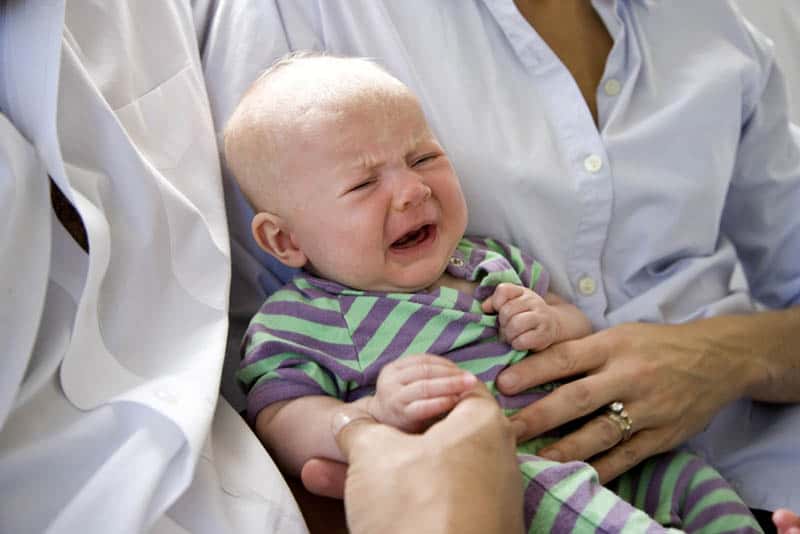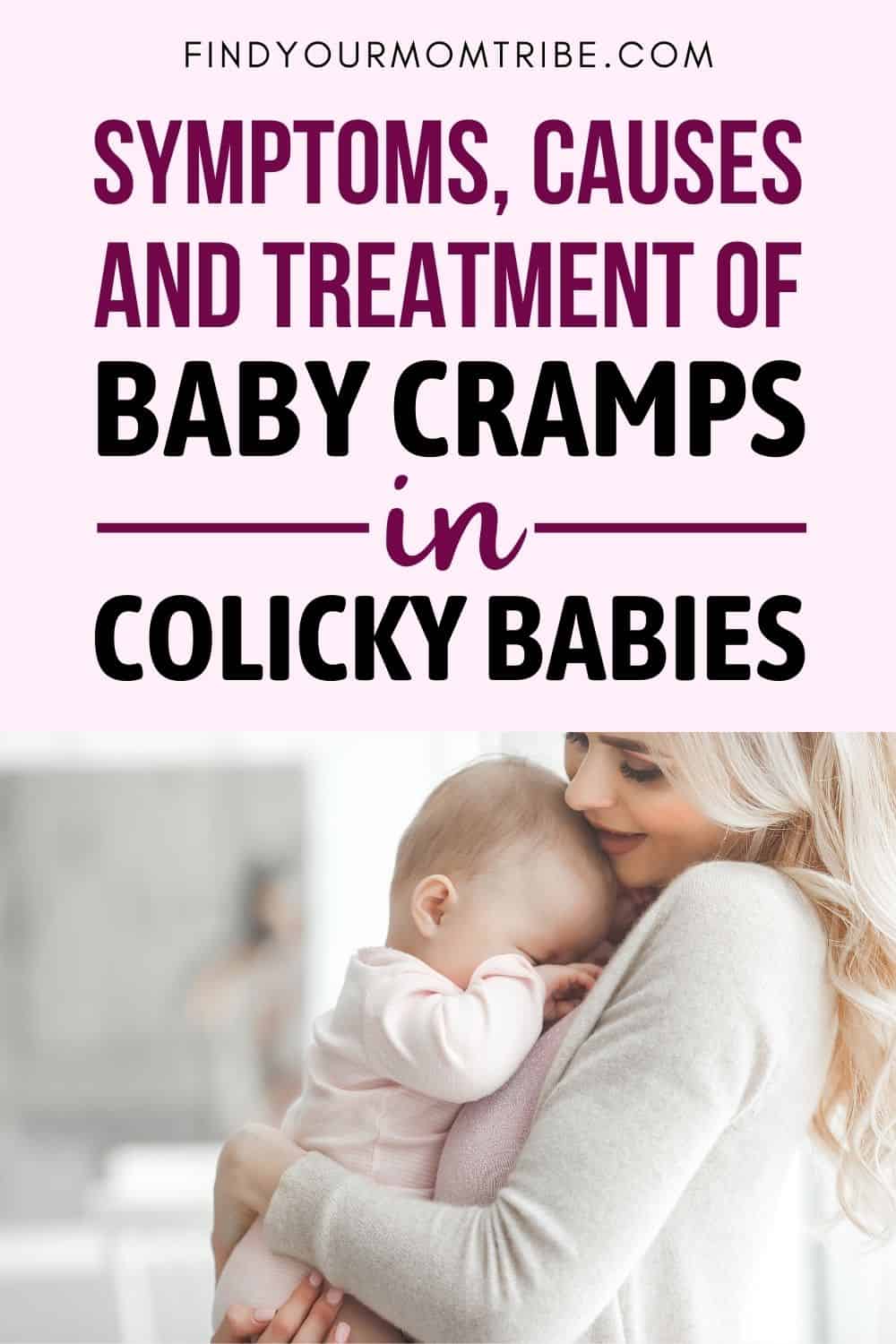Stomachaches and baby cramps are a frequent occurrence in newborn children and toddlers.
While baby cramps are usually nothing too dangerous or serious, it’s never good to leave them untreated.
We all like to be in the know when our little ones are showing signs of discomfort.
The most common reason for these cramps is infantile colic, otherwise known as fussiness.
If you have a fussy baby, that usually means inconsolable crying; a telltale sign that something might be wrong with your baby’s digestive system.
And it’s not that hard to tell the difference between regular crying and crying in pain, believe me. It’s a very ugly cry for the latter.
Colic is believed to be the root cause of baby cramps, brought on because a possible cause of colic is a very sudden and painful intestinal tightening that the baby can do nothing about so the baby cries due to having no other option.
That said, there are plenty of other symptoms of colic along with crying, and knowing how to spot these can mean a lot for your child.
If your baby’s crying is incessant and frequent but has no other visible symptoms, it’s always best to go to a doctor or any other healthcare professional for a check-up. Who knows, there might be something else afoot.
But, seeing as we’re here to see how we can resolve baby cramps and colicky babies, let’s see what the symptoms of colic are first.
Symptoms Of Colic Besides Baby Cramps

While colic has a whole handbook of symptoms, those that allude to stomach pains and other gastrointestinal issues can usually be put down to these most common ones:
• Fussiness/grumpiness
• Diarrhea
• Vomiting
• Unstoppable and excessive crying
• Refusing to eat
• The baby has issues going to sleep or doesn’t sleep at all
• Fidgeting
• Appearing to be visibly in pain and cringing or grimacing in discomfort
• Excess gassiness
• Rolling up into a fetal position when he cries
Then there are two other symptoms that can be standalone issues. These are constipation and acid reflux.
What is constipation and what are its symptoms?

While I’m certain many of you already know what constipation is, it’s always good to reiterate for those who don’t.
Constipation is something that affects both kids and adults alike and can be an aftereffect of colic.
It’s when the digestive system gets backed up, causing either a lack of stools or hardened stools that are difficult and painful to pass.
It’s these rough bowel movements that end up causing the aforementioned baby cramps.
Luckily, it’s relatively easy to spot the causes:
• Your child doesn’t have enough fiber in his diet – A simple solution is to introduce more fiber rich foods while keeping food allergies into account.
• The child isn’t hydrated enough – water helps soften the stool and also helps it move along. This is true of most of our bodily functions given how we’re 60% water. So make sure your little one is well hydrated at all times, especially during the hotter months.
• A recent medicine is causing it – side effects of medicine are not uncommon, and many of them include constipation. If that’s the case, look for an alternative medicine that reacts better with their bodies.
• Recent dietary changes – whenever there’s a change in the body’s daily routine, the body expresses it through some sort of abrupt reaction, harmful or otherwise, but it’s usually noticeable.
One of these can be constipation because the intestines have to adjust to the new material. It’s a frequent occurrence when your baby swaps feeding plans, perhaps from breastfeeding to solids, or when a new type of solid food is introduced. This one you’ll have to wait out, but adjustment usually only takes a few days.
• When the baby is holding his poops in – for whatever reason, your child may simply be trying to hold their bowel movements in for too long. Whether he thinks that’s a good thing or is simply confused about how pooping works, you have to make him understand that it’s not okay and that it’ll just cause him more problems.
• Your child has a milk allergy – While diarrhea is the more common consequence of an allergy to cow’s milk, it’s not that uncommon to end up feeling bloated and constipated because of it too.
Sometimes a young child’s body simply cannot process the milk protein (casein) or the lactose from cow’s milk (or even breast milk at times), which ends up causing discomfort in their tiny little tummies.
You might find your baby is gassy from breastfeeding or from formula that contains lactose, and they end up dealing with very painful gas issues.
It’s a problem that both bottle fed and breastfed babies are prone to, and it can be quite the issue during the child’s first year.
Also known as milk soy protein intolerance (MSPI), it might require a different diet on your part if you’re breastfeeding.
If that ends up being the case, simply omit dairy that comes from cow’s milk from their diet (and sometimes dairy in general), and you’ll see an improvement.
If being bloated is an issue (something that is most certainly going to lead to a fussy/ colic-ridden baby), then you might want to help burp your baby.
Burping helps to relieve pressure on his gastrointestinal tract and makes your child’s day a whole lot better once all the gas is expelled from his body.
The other remedies for constipation simply include using natural diuretics like prunes and promoting more physical movement to get the intestines going again.
What is acid reflux and what are its symptoms?

Acid reflux (or gastroesophageal reflux), on the other hand, is when you get stomach acid backing up and climbing up back the oesophagus, causing an awful burning sensation in the back of the throat, which doesn’t have the same protective lining as your intestines.
For kids, that’s a nightmarish pain that they don’t know the source of, so they end up crying uncontrollably and being fussy, eventually leading to baby cramps and colic.
For adults, it might be better known as heartburn, and when you experience that, you can understand why babies cry when it happens to them.
Plus, in babies, it might be a slightly more complicated issue known as GERD (gastroesophageal reflux disease), which can be tough to deal with for any child.
Its symptoms usually boil down to:
• Hiccupping
• Lots of choking and gagging throughout the day
• Difficulties breathing/wheezing
• Poor weight gain/not enough for the baby’s expected growth
• Outright refusal to eat
• A lot of dry coughing from throat irritation (more frequent at night or whenever the baby is in a horizontal position for a longer period of time)
• Frequent spit up and vomiting episodes
• Ear infections
• Chest rattling
There are quite a few serious symptoms there that aren’t particularly easy to solve, especially since children aren’t allowed to take most of the same medicine as adults due to their intestinal flora not being as developed as that of grown adults.
That said, the best thing you can do is contact a pediatrician, a family doctor or any other certified healthcare professional for expert medical advice regarding the situation.
The diagnoses and treatments offered usually include advice on utilizing positions that help keep the baby upright in both breastfeeding and bottle feeding.
This is done so that the stomach acid has a harder time climbing up the oesophagus, hence the earlier mention of the horizontal position.
They’ll also be able to prescribe you certain medication to enhance the child’s metabolism.
They help absorb the stomach acids and empty the bowels faster so the acids have a smaller window where they can climb up to the throat.
But luckily, this is only a temporary issue and not something that’s going to follow your child throughout their entire life.
Most kids get it when they’re a few weeks of age, and then it goes away when they reach their first birthday because their digestive system develops enough to fend it off properly.
What Is Colic, Though?

Colic is really tough to explain because it is an umbrella term that covers a broad range of ailments.
But, as mentioned earlier, it’s usually a state that your child is in when they’re incessantly crying due to an issue within their body that they cannot explain themselves.
The problems are usually something that causes their nervous system to act up, creating discomfort and/or pain that they can’t get rid of on their own too easily.
Overstimulation from a certain cluster of nerves sends out jolts of pain and causes that specific part of the body to cramp up inexplicably.
It’s generally assumed that colic happens due to the still-developing nervous system, meaning that it gets confused at times and sends out false signals.
The other potential cause is that it’s just an aftereffect of another problem that occurred at one point that the body overreacted to.
It’s something that usually occurs when the baby is around 2-3 months of age, but your child’s body will eventually develop so that colic will no longer be an issue, and you’ll have a healthy baby again.
What Causes Colic?

While knowing the symptoms of colic is vital, it’s important to note what other possible causes there are in the first place so you too can potentially assess the gravity of the situation.
The most common causes of colic are:
• An undeveloped digestive system (e.g., one that’s sensitive to even breast milk or baby formula)
• Overstimulation of the nervous system
• Underfeeding to the point of starvation or getting more food than the digestive system can handle
• From problems with digesting food or accumulated gas in the digestive tract
• Excessive response of emotions like anger, excitement, or terror
• Some forms of newborn migraines
While some might be pretty common, they are at least avoidable in case you’re trying to pre-emptively prevent them, though some of these factors remain out of your control
That said, it’s good to know where the root of the problem is coming from when it comes to treating colic.
How To Treat Colic?

As different as its causes can be, treating colic also involves a whole host of potential remedies.
Some might work, some might not. It all really depends from child to child, but all of them are easy enough to figure out and are worth knowing.
Some of the best methods of treating colic are:
• Using a pacifier to help keep the child’s focus away from the source of the pain
• Swaddle the child in a swaddling blanket or something similar to help keep him warm and safe
• Turning a white noise machine on to help calm the child down
• Rocking the baby in your arms gently, making sure to move around
• Giving your baby a warm bath to help him calm down and to help his muscles relax
As you can see, most of these are pretty basic, but I would still suggest going to a doctor or a pediatrician for a physical exam to see if everything is alright with the baby in case there’s another issue under the surface.
One thing they’ll suggest for treating colic is using simethicone medicine in case gassiness is an issue.
That’s because simethicone helps bind the bubbles together and allows the gas to pass by a lot more easily without upsetting the baby’s stomach.
The other thing that they’re likely to prescribe is some child-friendly probiotics to help improve the bacterial flora inside their digestive tract, remedying whatever is bothering your little one’s tummy and causing those baby cramps.
In Conclusion
Baby cramps can be a real pain to deal with, especially when colic is involved in the process, as it’s one of its main causes.
The worst part is when the cause comes down to GERD or constipation as well because this can be a really painful and uncomfortable experience for your little one.
Luckily, it’s not a condition that ends up following them throughout their life, but it’s always best if it gets treated as soon as possible so as not to risk any further complications that might arise because of it.
And the fact that all of the remedies are relatively simple makes it less of an issue than it might seem on the surface.
That said, don’t take it too lightly and still make sure to check in with a pediatrician, doctor, or any other relevant healthcare professional who can help further diagnose the problem and give you specific instructions on how to deal with the matter at hand.
Stick to what they tell you, and by the end of your baby’s first year, colic and baby cramps will be a thing of the past!
Like this post? Please share or pin it for later. You can also stay in the loop and follow us on Facebook, Instagram or Pinterest.

This post contains affiliate links. Please see our full disclosure for more info.

